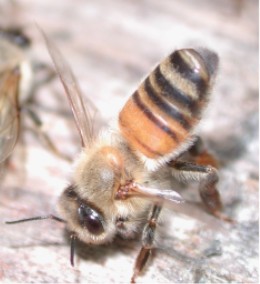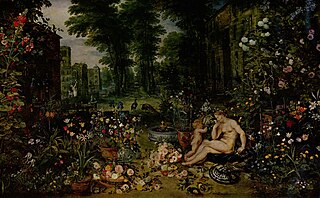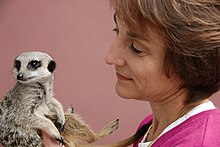
A pheromone is a secreted or excreted chemical factor that triggers a social response in members of the same species. Pheromones are chemicals capable of acting like hormones outside the body of the secreting individual, to affect the behavior of the receiving individuals. There are alarm pheromones, food trail pheromones, sex pheromones, and many others that affect behavior or physiology. Pheromones are used by many organisms, from basic unicellular prokaryotes to complex multicellular eukaryotes. Their use among insects has been particularly well documented. In addition, some vertebrates, plants and ciliates communicate by using pheromones. The ecological functions and evolution of pheromones are a major topic of research in the field of chemical ecology.

The vomeronasal organ (VNO), or Jacobson's organ, is the paired auxiliary olfactory (smell) sense organ located in the soft tissue of the nasal septum, in the nasal cavity just above the roof of the mouth in various tetrapods. The name is derived from the fact that it lies adjacent to the unpaired vomer bone in the nasal septum. It is present and functional in all snakes and lizards, and in many mammals, including cats, dogs, cattle, pigs, and some primates. Some humans may have physical remnants of a VNO, but it is vestigial and non-functional.

In ethology, territory is the sociographical area that an animal consistently defends against conspecific competition using agonistic behaviors or real physical aggression. Animals that actively defend territories in this way are referred to as being territorial or displaying territorialism.

The house mouse is a small mammal of the order Rodentia, characteristically having a pointed snout, large rounded ears, and a long and almost hairless tail. It is one of the most abundant species of the genus Mus. Although a wild animal, the house mouse has benefited significantly from associating with human habitation to the point that truly wild populations are significantly less common than the semi-tame populations near human activity.
A kairomone is a semiochemical, emitted by an organism, which mediates interspecific interactions in a way that benefits an individual of another species which receives it and harms the emitter. This "eavesdropping" is often disadvantageous to the producer. The kairomone improves the fitness of the recipient and in this respect differs from an allomone and a synomone. The term is mostly used in the field of entomology. Two main ecological cues are provided by kairomones; they generally either indicate a food source for the receiver, or the presence of a predator, the latter of which is less common or at least less studied.
Kin recognition, also called kin detection, is an organism's ability to distinguish between close genetic kin and non-kin. In evolutionary biology and psychology, such an ability is presumed to have evolved for inbreeding avoidance, though animals do not typically avoid inbreeding.

The Algerian mouse, also known as the western Mediterranean mouse, is a wild species of mouse closely related to the house mouse, native to open habitats around the western Mediterranean.
A cat pheromone is a chemical molecule, or compound, that is used by cats and other felids for communication. These pheromones are produced and detected specifically by the body systems of cats and evoke certain behavioural responses.

Catherine Dulac is a French–American biologist. She is the Higgins Professor in Molecular and Cellular Biology at Harvard University, where she served as department chair from 2007 to 2013. She is also an investigator at the Howard Hughes Medical Institute. She was born in 1963 in France. She came to the United States for her postdoctoral study in 1991.
Cauxin is a carboxylesterase that is excreted in large amounts in cat urine. There is also evidence that it can serve as a peptide hydrolase in the production of cat pheromone precursors. Cauxin has a mass of 70 kilodaltons and is composed of 545 amino acids. The protein can also exist as a multimeric protein complex connected by disulfide bonds with a mass of 300-350 kilodaltons. This is its primary form in non-reducing conditions. The proximal tubules of epithelial cells in the kidney express cauxin. This protein is secreted into the urine from the renal tubular cells. The gene for the protein is also found in several other mammalian genomes in various organs. However, the only mammals that have cauxin present in urine are cats. It is also the first carboxylesterase to be found in urine.

An odor or odour is caused by one or more volatilized chemical compounds that are generally found in low concentrations that humans and many animals can perceive via their sense of smell. An odor is also called a "smell" or a "scent", which can refer to either an unpleasant or a pleasant odor.

The sense of smell, or olfaction, is the special sense through which smells are perceived. The sense of smell has many functions, including detecting desirable foods, hazards, and pheromones, and plays a role in taste.

Major urinary proteins (Mups), also known as α2u-globulins, are a subfamily of proteins found in abundance in the urine and other secretions of many animals. Mups provide a small range of identifying information about the donor animal, when detected by the vomeronasal organ of the receiving animal. They belong to a larger family of proteins known as lipocalins. Mups are encoded by a cluster of genes, located adjacent to each other on a single stretch of DNA, that varies greatly in number between species: from at least 21 functional genes in mice to none in humans. Mup proteins form a characteristic glove shape, encompassing a ligand-binding pocket that accommodates specific small organic chemicals.
The Bruce effect, or pregnancy block, is the tendency for female rodents to terminate their pregnancies following exposure to the scent of an unfamiliar male. The effect was first noted in 1959 by Hilda M. Bruce, and has primarily been studied in laboratory mice. In mice, pregnancy can only be terminated prior to embryo implantation, but other species will interrupt even a late-term pregnancy.
Odour is sensory stimulation of the olfactory membrane of the nose by a group of molecules. Certain body odours are connected to human sexual attraction. Humans can make use of body odour subconsciously to identify whether a potential mate will pass on favourable traits to their offspring. Body odour may provide significant cues about the genetic quality, health and reproductive success of a potential mate.

The Great Pheromone Myth is a book on pheromones and their application to chemosensation in mammals by Richard L. Doty, director of the University of Pennsylvania's Smell and Taste Center in Philadelphia. Doty argues that the concept of pheromone introduced by Karlson and Lüscher is too simple for mammalian chemonsensory systems, failing to take into account learning and the context-dependence of chemosensation. In this book, he is especially critical of human pheromones, arguing that not only are there no definitive studies finding human pheromones, but that humans lack a functional vomeronasal organ to detect pheromones. Its publication received coverage in the news media, especially concerning its arguments that human pheromones do not exist.
The Hoover-Drickamer effect occurs when adult female mice are exposed to the urine of pregnant and lactating adult female mice, resulting in a longer than typical oestrus period. The effect was first noted by J. E. Hoover and L. C. Drickamer in their 1979 study wherein they randomly assigned adult female mice to one of four treatment conditions: a control group where the subjects were exposed to water, a group that was exposed to the urine of pregnant mice, a group that was exposed to the urine of lactating mice and a group that was exposed to the urine of a singly caged female mouse.

Scent rubbing is a behavior where a mammal rubs its body against an object in their environment, sometimes in ones covered with strongly odored substances. It is typically shown in carnivores, although many mammals exhibit this behavior. Lowering shoulders, collapsing the forelegs, pushing forward and rubbing the chin, temples, neck, or back is how this act is performed. A variety of different odors can elicit this behavior including feces, vomit, fresh or decaying meat, insecticide, urine, repellent, ashes, human food and so on. Scent rubbing can be produced by an animal smelling novel odors, which include manufactured smells such as perfume or motor oil and carnivore smells including feces and food smells.
Christine Nicol is an author, academic and a researcher. She is a Professor of Animal Welfare at the Royal Veterinary College and has honorary appointments at the University of Oxford and the University of Lincoln. She is the Field Chief Editor of Frontiers in Animal Science.

Olfactic communication is a channel of nonverbal communication referring to the various ways people and animals communicate and engage in social interaction through their sense of smell. Our human olfactory sense is one of the most phylogenetically primitive and emotionally intimate of the five senses; the sensation of smell is thought to be the most matured and developed human sense.












